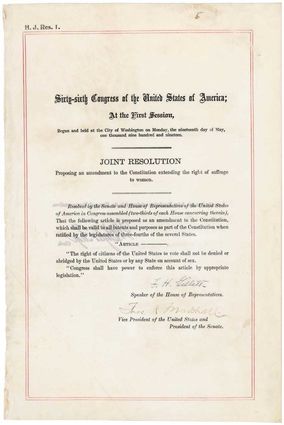Celebrating the right to
Congress passed the 19th Amendment 100 years ago
August 20, 2020
2020 marks the 100-year anniversary of the official adoption of the 19th Amendment; which guarantees and protects a woman’s constitutional right to vote. This right was not simply given to women; the fight for the vote began long before the 19th Amendment was officially ratified on August 26, 1920. The belief that women and men are all equal, and should be given a fair and just voice in this country, resonates just as strongly with women today, as it did with women of the 20th century. Those who fought for women’s suffrage, and the feminist movement throughout the 20th century, fought for the right to their own political identity.
Suffragists organized the first Woman’s Rights Convention in the year 1848 in Seneca Falls, New York. This pivotal moment in history is when the women’s suffrage movement made its identity known in the United States. The women’s suffrage movement incited 72 years of marches and protests which led to repeated arrests on charges of “unlawful assembly.” Hunger strikes led to forced tube feedings. Violent attacks on the streets included women being knocked to the ground and having signs ripped from their hands. These moments collectively gave women the momentum and purpose to hold the government accountable as they continued to fight for the belief that they, like men, should be granted the same constitutional rights that allow them to have a voice in their country.
“The 19th Amendment prohibits state and federal government from denying U.S. citizens the right to vote based on their sex. Passage of the 19th Amendment is a great example of how the founders set up a system that allowed the U.S. Constitution to be lawfully amended in accordance with the will of the people,” Senator Jennifer Fielder of Thompson Falls stated. “It is also an example of the fact that the U.S. Constitution is a wonderful tool to restrict the government from denying the God-given-rights of the American people. That is why it is so important that ‘we the people’ are diligent in knowing what it says and insisting that government officials obey it.”
The League of Women Voters is a civic organization that was founded in 1920 to help women take a larger role in policies after they won the right to vote. The League was founded by Carrie Chapman Catt, an American women’s suffrage leader, who served as president of the National American Women Suffrage Association (NAWSA). Catt proposed the establishment of a “league of women voters to finish the fight and aid in the reconstruction of the nation.” Six months before the official ratification of the 19th Amendment, on February 14, 1920, the new league was officially formed. Catt described the purpose of the organization, “the League of Women Voters is not to dissolve any present organization but to unite all existing organizations of women who believe in its principles. It is not to lure women from partisanship but to combine them in an effort for legislation which will protect coming movements, which we cannot even foretell, from suffering the untoward conditions which have hindered for so long the coming of equal suffrage. Are the women of the United States big enough to see their opportunity?”
Today, Clare Kearns, co-president of the Helena League of Women Voters, carries the same belief, to remain vigilant to any threat to a woman’s right to vote, just as her founder did. “Women’s fight for equality has been going on at least since the United States declared independence from Great Britain when Abigail Adams implored her husband to “remember the ladies” when creating the Declaration of Independence. At this time in history, women could not own property or sign legal documents, could not control their own money, and could not vote,” Kearns said. “Laws written at that time stated when women married, they lost their legal identity. Abigail’s efforts were for naught. Gender equality was generally met with shock and scorn by a population that generally considered men superior to women.”
As we reflect on the last 100 years, even today, it is important for both women and men of all ages to see the barriers suffragists broke through that in return should remind everyone not to take their rights for granted. Women fighting for equality and the right to vote, Kearns says, “culminated in the birth of the suffragists movement. It took another 97 years for women to finally be guaranteed the right to vote. That was in 1920. One hundred years ago this year.” Kearns continued, “Given the decades it took and the intense resistance women met during their fight for the right to vote, we must not take that right for granted. We must exercise that right and be ever vigilant to ensure that right is never compromised.”
While there were men in favor of women voting; there were also both men and women who believed that suffrage was a right that didn’t belong to any of the women in this country. Even as opposition to ratification was met head on, legislatures felt the pressures to ratify the amendment as more and more states approved limited to full suffrage for women.
Montana’s men voted to end discrimination against women in 1914, making Montana one of the original 36 states to ratify the 19th Amendment. Montana was one of the states where women won full suffrage rights. Leading the fight to the successful campaign was Jeanette Rankin. Two years later in 1917, Montana voters elected Rankin to serve as the first woman in the U.S. House of Representatives. Not only was Rankin the first woman member of Congress, she was the first woman in the country to be elected to national office.
“Montanans have always been trailblazers. We can all be proud that Montanans elected Jeanette Rankin to the U.S. House of Representatives,” Montana attorney Monica Tranel stated. Tranel, who is currently running for election to the Montana Public Service Commission to represent District 4, remembers a world where women were not allowed to vote. “Both my grandmothers were born into a world where women couldn’t vote. They were both fierce, hardworking women who valued education and the contributions women make to our world. Jeanette helped pass the 19th Amendment, so women like my grandmothers, who contributed to their families and communities in so many other ways, were also given the respect and duty they deserved – the right to vote,” Tranel said. “I have three daughters, and I want them to know that when they join the women today who contribute so much to business, government and civic life in Montana, they will be standing on Jeanette Rankin’s shoulders.”
As we mark this centennial day in history, and honor the women who celebrated 100 years ago, came up short for women of color. The Amendment stated the right to vote “shall not be denied by any State on account of sex.” Many women of color found themselves unable to cast a vote in local or federal elections. African American women were shut out of the polls – notably in the southern states – as they were met with barriers such as literacy tests and poll taxes. This also included many Native American and Asian American women who were not yet granted citizenship.
The right of women to vote today is still under attack. Kearns explained the modern-day efforts that are used to suppress the vote. “Mass purges of voter rolls, redrawing district boundaries, requiring a specific address or a specific ID to vote, reducing the time allowed to vote, having elections on a work day, and spreading misinformation on mail-in ballots,” Kearns said. “Women and men are impacted by these maneuvers, but women, especially low-income and minority women, are disproportionately impacted. Women who have both childcare and job responsibilities, find it difficult to vote on a work-day or to vote during limited hours. Native American women who live in remote areas without typical addresses struggle to get mail-in ballots or even to simply register to vote. Additionally, with responsibilities for care of ill family members and lack of transportation, some Native American women struggle to get to the polls to vote in person.”
As we do our best to recognize the fight that all women have endured on their quest for equality, we must also recognize the fight continues. Kearns continued, “Grandmothers, great-grandmothers and great-great-grandmothers of women and men living today had a vision for democracy. That vision was that women and men could participate equally in shaping the United States government.”








Reader Comments(0)